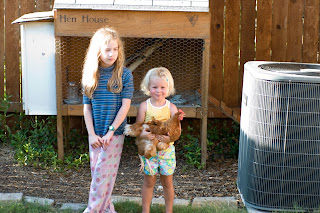 Benefits
BenefitsEnvironmental Benefit: ★★★☆☆
Keeping your own backyard chickens has a number of advantages. They will eat bugs in the area they patrol, while they fertilize that same area. They'll eat most of your food scraps, reducing waste going down the drain or into the landfill. And you won't need to buy store eggs, so packaging and energy waste associated with that activity is eliminated.
Money Saved: ★★☆☆☆
I've calculated the cost of purchase and feeding our hens vs. the eggs they lay (they lay 2 eggs every 3 days, each!). It works out to be about equal to the cost of buying cheap eggs at the grocery. However, if you compare it to the cost of organically fed, free-range chicken eggs (which ours are) then you are saving money.
Lifestyle Benefit: ★★★☆☆
If you have kids, then chickens are a "productive" pet. You always have fresh eggs at hand! We live in a rural subdivision, but the neighbors haven't minded our two hens as they're quiet (don't crow like roosters) and don't smell. Chickens only smell if you keep a good number cooped up in a small area, with their waste accumulating. Even after about four years having chickens, the younger kids still get excited about finding eggs and bringing them in. And we haven't had a fireant problem in our backyard since the chickens moved in! To be honest, they are a bit hard on the lawn (they like to scratch all the time) - so if you are concerned about that then I would fence them in their own little "run" to minimize damage. Also, don't let them get into your garden with young seedlings planted, as they will dig them up and probably eat them. Larger plants are safe around them.
 What We're Doing
What We're DoingWhen we got our two hens, I made the little henhouse you see pictured here (one of the two girls pictured isn't ours, by the way). The nesting box on the side is an extra kitchen cabinet that was in our garage when we bought the house. It has a ramp on the side, and the hens go "home" by themselves every evening to roost on a pole that extends across the top part you can't see (under the roof overhang, for weather protection). The nesting box has a little hay in it to make it comfortable. There is a sliding plank door that can be closed to keep them safe from other critters at night if necessary. They're quite sociable, and like to hang around our back door watching us having dinner and hoping for handouts. They'll eat just about any of the leftovers from our plates, but we draw the line at giving them chicken! I don't think they'd probably hesitate at becoming cannibals but somehow that doesn't seem right! In addition to the table scraps, we also feed them poultry feed from our local farm supply store and some scratch grains. That provides them with the calcium they need for making shells, as well as extra protein. Three 50lb bags last us about a year with two hens. You can buy the chickens as chicks and raise them, but we went the easier route and bought them at several months old already - and just about ready to start laying. By the way, no rooster is needed to have laying hens (that's a common misconception).
A Little Humor
Q. Why Couldn't The Chicken Find Her Eggs?
A. Because She Mislaid Them.
Q. What Goes Peck, Peck, Peck, Boom?
A. A Chicken In A Mine Field.
Q. Why did the chicken cross the road?
Answers:
Pat Buchanan: To steal a job from a decent, hard-working American.
Roseanne: Urrrrrp. What chicken?
Jack Benny: I'm thinking. ... I'm thinking
Buddha: If you ask this question, you deny your own chicken nature.
James Cagney: It crossed twice. The dirty double-crosser.
Albert Camus: It doesn't matter; the chicken's actions have no meaning except to him.
Darwin: Chickens, over great periods of time, have been naturally selected in such a way that they are now genetically predisposed to cross roads
James Dean: To prove he wasn't chicken.
Emily Dickenson: Because it could not stop for death.
Albert Einstein: Whether the chicken crossed the road or the road crossed the chicken depends upon your frame of reference.
Grandpa: In my day, we didn't ask why the chicken crossed the road. Someone told us that the chicken had crossed the road, and that was good enough for us.
Ernest Hemingway: To die. In the rain.
Sherlock Holmes: Do not concern yourself with the chicken that did cross the road; the answer lies with the chicken that did not cross the road.
Machiavelli: The point is that the chicken crossed the road. Who cares why? The ends of crossing the road justify whatever motive there was.
Groucho Marx: Chicken? What's all this talk about chicken? Why, I had an uncle who thought he was a chicken. My aunt almost divorced him, but we needed the eggs.
Jackie Mason: Whaddaya want, it should just stand there?
Pyrrho the Skeptic: What road?
Colonel Sanders: I missed one?
Dr. Seuss: Did the chicken cross the road? Did he cross it with a toad? Yes the chicken crossed the road, but why he crossed, I've not been told!
O.J.Simpson: It didn't. I was playing golf with it at the time.
B.F. Skinner: Because the external influences, which had pervaded its sensorium from birth, had caused it to develop in such a fashion that it would tend to cross roads, even while believing these actions to be of its own freewill.
Joseph Stalin: I don't care. Catch it. I need its eggs to make my omelet.
Thomas de Torquemada: Give me ten minutes with the chicken and I'll find out.
 Benefits
Benefits






 Benefits
Benefits








